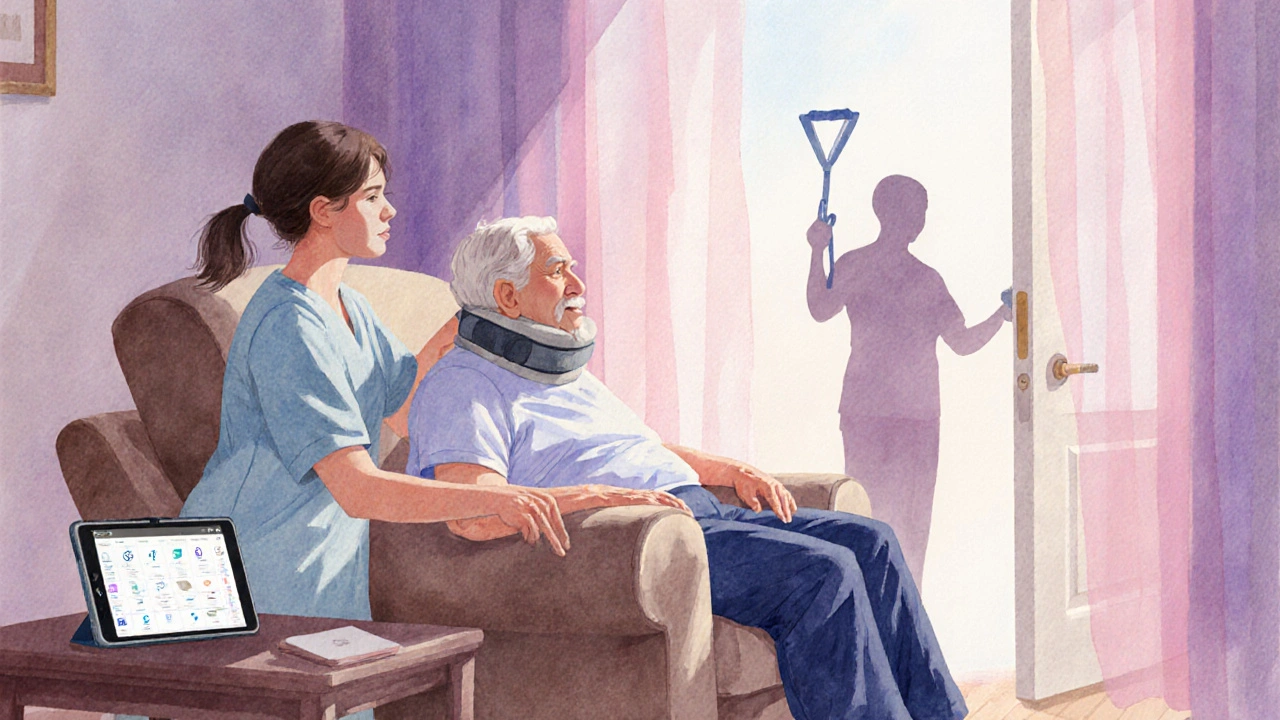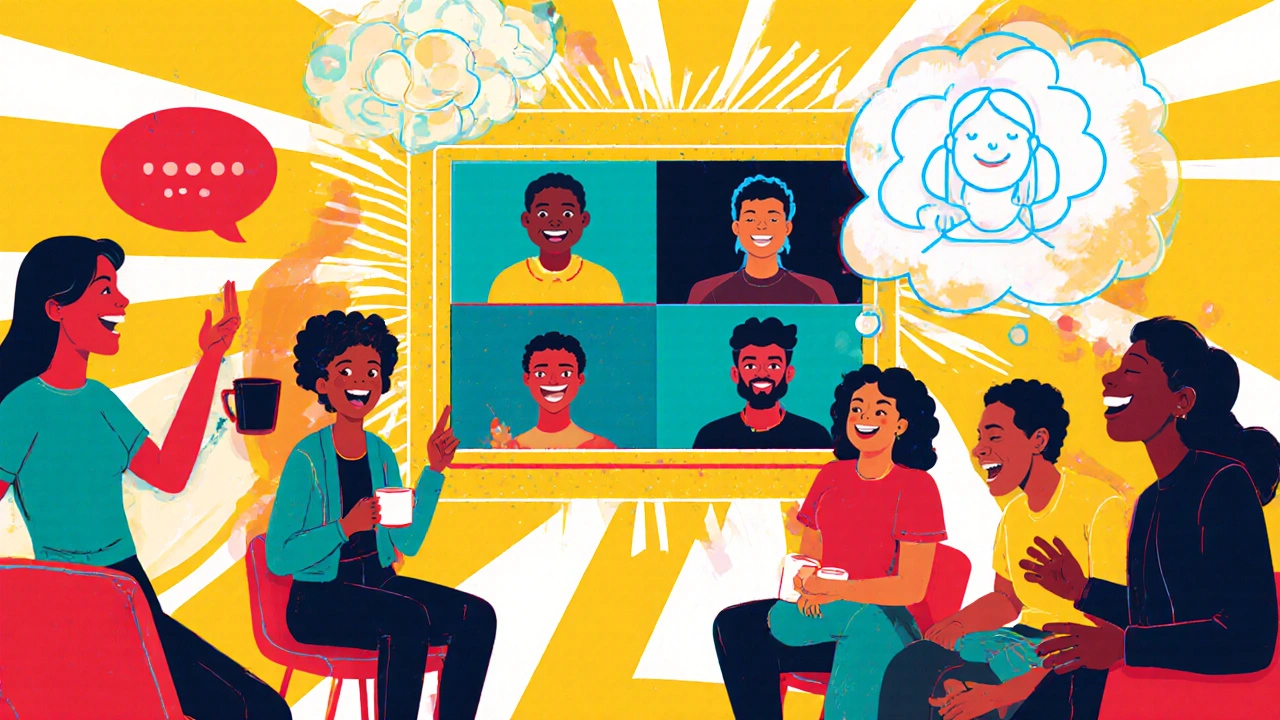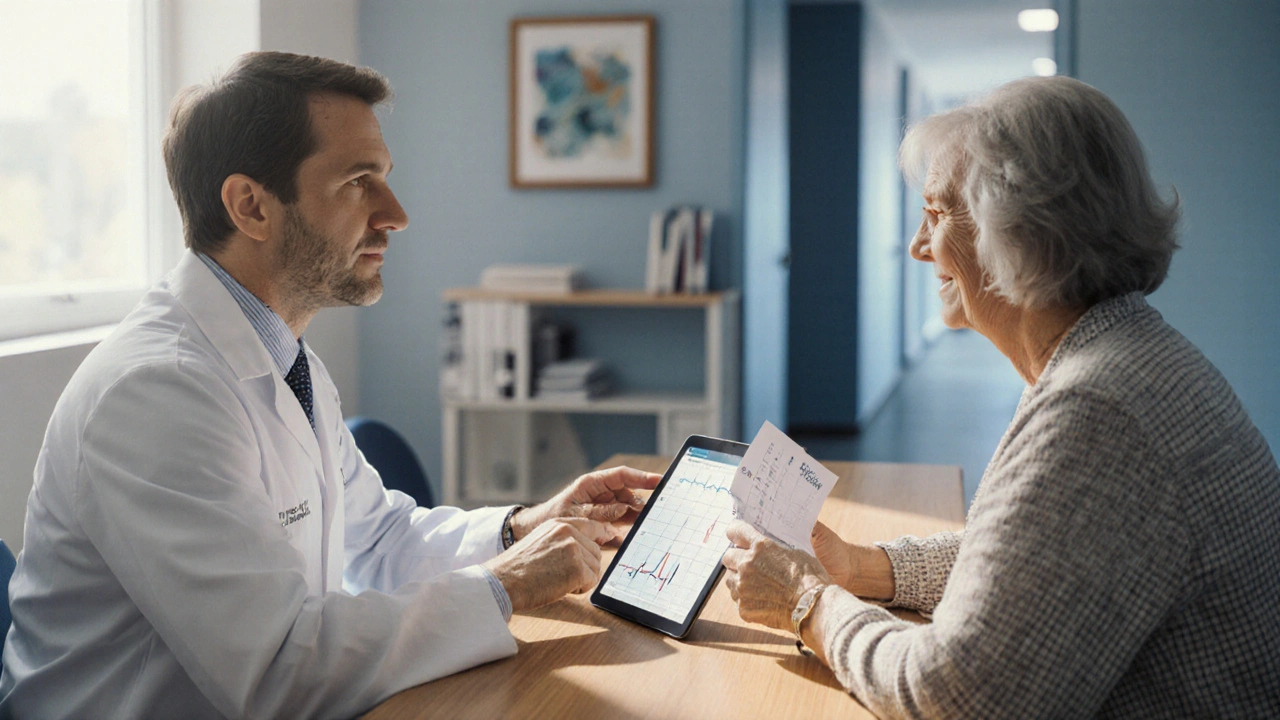Myasthenia Gravis Support System Planner
Medical Team
Your neurologist and allied health professionals
Caregivers
Family and professional support
Community
Peer groups and digital tools
Key Takeaways
- Effective support for Myasthenia Gravis (MG) blends medical care, family involvement, peer connections, and digital tools.
- Identify three core pillars: professional team, caregiver network, and community resources.
- Start small - a local meet‑up or a private online group can grow into a robust system.
- Choose tools that match your lifestyle: symptom trackers for daily monitoring, telehealth for quick questions.
- Revisit the plan every 6‑12 months to adjust for symptom changes or new therapies.
What Myasthenia Gravis Is and Why Support Matters
When caring for Myasthenia Gravis is a chronic autoimmune disorder that weakens the skeletal muscles, the day‑to‑day reality can feel unpredictable. A simple yawn might trigger drooping eyelids, and a mild infection can flare up weakness for weeks. That volatility makes a solid support network not just nice to have-it’s essential for staying safe, managing stress, and keeping treatment on track.
People with MG often report feeling isolated because the condition is rare (about 20 per 100,000 adults). Isolation can worsen fatigue and depression, which in turn makes symptoms flare. A well‑structured support system breaks that cycle by providing reliable information, emotional backup, and quick access to help when a crisis hits.
Core Pillars of a Support System
Think of your support network as a three‑legged stool. If any leg is missing, the stool wobbles. Below are the pillars you should build from the ground up.
1. Medical Team
First and foremost, you need a Neurologist who specializes in autoimmune neuromuscular disorders. This doctor prescribes acetylcholinesterase inhibitors, immunosuppressants, or newer monoclonal antibodies and monitors blood tests. Having a clear point of contact reduces the chance of mixed messages when you see multiple specialists.
Don’t forget allied health professionals. A Physical Therapist can design low‑impact exercises that maintain muscle strength without triggering fatigue. A speech‑language pathologist helps with swallowing difficulties, a common MG symptom.
2. Family & Caregivers
Family members often become the unofficial case managers. A dedicated Caregiver knows medication schedules, tracks symptom patterns, and can spot early warning signs. Training a caregiver in basic emergency response-like recognizing a myasthenic crisis-saves critical minutes.
Encourage caregivers to attend at least one clinic visit each quarter. Seeing the doctor in action demystifies the disease and builds confidence in managing care at home.
3. Peer Support & Community Resources
Connecting with others who live with MG cuts the feeling of “being the only one.” Look for a local Support Group organized by a patient‑advocacy organization. These gatherings often feature guest speakers, medication updates, and practical tips like energy‑conserving hacks.
If a nearby group isn’t an option, turn to national bodies such as the Myasthenia Gravis Foundation of America (MGFA) or the Myasthenia Gravis Association (MGA). They provide webinars, printed guides, and a directory of vetted clinicians.

Starting a Local Support Group
Launching a group may sound daunting, but you can keep the overhead low.
- Pick a neutral venue: community center rooms, library meeting spaces, or even a coffee shop during quiet hours.
- Set a regular schedule-once a month works for most people.
- Send a simple invitation through the MGFA’s local chapter newsletter or via a Facebook event.
- Prepare a brief agenda: quick introductions, a spotlight on a recent research update, and open‑floor sharing.
- Collect contact info (with consent) to create an email list for future updates.
After a few meetings, you’ll notice recurring themes-like medication side‑effects or fatigue‑management tips. Those patterns help you tailor future sessions and even invite guest speakers who address the most pressing needs.
Leveraging Online Communities
Virtual groups fill the gaps when geography or mobility limit in‑person meet‑ups. Platforms such as Reddit’s r/MyastheniaGravis, MGFA’s private Facebook groups, and dedicated forums on PatientsLikeMe allow members to post questions, share experiences, and flag new research.
When you join an online community, follow these safety habits:
- Verify that moderators are knowledgeable-look for credentials like “MD” or “MGFA Certified.”
- Avoid sharing personal health identifiers unless the group is encrypted.
- Cross‑check any medical advice with your neurologist before acting on it.
These steps keep the conversation supportive and trustworthy.
Choosing the Right Digital Tools
Technology can streamline symptom tracking, appointment reminders, and medication adherence. Below is a quick side‑by‑side look at two popular approaches.
| Feature | In‑Person Support | Virtual Support |
|---|---|---|
| Interaction Type | Face‑to‑face, hands‑on activities | Video calls, chat forums |
| Accessibility | Requires travel, limited to local area | Accessible from any device with internet |
| Cost | Often free but may incur venue fees | Usually free; premium apps may charge subscription |
| Community Size | Smaller, tight‑knit groups | Potentially large, diverse participants |
| Examples | Local MGFA chapter meet‑up | Reddit r/MyastheniaGravis, MGFA private Facebook group |
Pick the mix that fits your energy levels. Some patients attend a monthly in‑person gathering for personal connection while using a virtual forum daily for quick tips.
Popular Symptom Tracker App includes Myasthenia Gravis Tracker and MG Diary, both offering medication logs, fatigue scores, and exportable reports for your neurologist. Pair an app with a Telehealth Platform like Doxy.me or MyChart, and you can consult your doctor from the couch when a flare spikes.

Keeping the System Alive
A support network isn’t a set‑and‑forget checklist. Life changes-new jobs, moving homes, treatment updates-can shift the balance. Schedule a “support audit” every six months:
- Review medication list with your neurologist.
- Ask your caregiver how the current routine feels; adjust duties if burnout shows.
- Poll your peer group on topics they’d like covered next.
- Test any new apps for usability; discard ones that add clutter.
- Update emergency contacts and share the latest plan with all members.
Document each audit in a shared Google Doc or a private note‑taking app. Having a written record makes transitions smoother if you ever need to hand off care to a new caregiver.
Common Pitfalls and How to Avoid Them
Even well‑intentioned plans can stumble. Here are three frequent issues and quick fixes.
- Over‑committing to meetings. If you find yourself exhausted after group sessions, trim them down to 30‑minute check‑ins or switch to a virtual format.
- Relying on a single information source. Cross‑reference news from MGFA, peer‑reviewed journals, and your doctor to avoid misinformation.
- Neglecting caregiver self‑care. Encourage your caregiver to schedule their own doctor visits and leisure activities; a rested supporter is more effective.
Addressing these early prevents frustration and keeps the whole team motivated.
Putting It All Together: A Sample Action Plan
Below is a concise roadmap you can copy, paste, and customize.
- Identify your core medical contacts. Write down names, phone numbers, and preferred contact hours.
- Choose a primary caregiver. Discuss responsibilities and set weekly check‑in times.
- Join or start a support group. Use the steps in the “Starting a Local Support Group” section.
- Pick a symptom‑tracking app. Download, set up daily reminders, and share weekly reports with your neurologist.
- Schedule a telehealth appointment. Test the platform a day before your first virtual visit.
- Plan a 6‑month audit. Mark the calendar now so you won’t forget.
Follow this checklist and tweak it as your needs evolve. You’ll find that a well‑crafted network makes daily life feel less like a solo marathon and more like a relay race where everyone passes the baton.
Frequently Asked Questions
How often should I meet with my support group?
Monthly meetings work for most patients. If you’re in a flare‑heavy phase, consider bi‑weekly virtual check‑ins to keep the momentum without adding travel fatigue.
Can I rely solely on an app for medication management?
Apps are great for reminders, but always keep a printed copy of dosages and a backup alarm. A sudden app glitch shouldn’t leave you missing a dose.
What if I don’t have family nearby to act as a caregiver?
Professional home‑health aides, local senior centers, or volunteer services through organizations like the Red Cross can fill that role. Train them on MG‑specific emergency signs.
Is it safe to share my medical details on public forums?
Never post identifiable information (full name, address, exact medication doses) on open forums. Use private groups with verified moderators for deeper discussions.
How can I help my caregiver avoid burnout?
Encourage scheduled breaks, share responsibilities with another family member, and provide resources for caregiver support-many hospitals run separate counseling sessions for them.
Building a sturdy support system is a marathon, not a sprint. With the right mix of medical expertise, personal allies, peer connections, and smart tech, you can turn uncertainty into confidence. Ready to take the first step? Start by listing the people and tools you already have, then fill the gaps using the guide above.


Louis Robert
October 5, 2025 AT 12:30Great overview, this plan will really help patients feel less alone.
tim jeurissen
October 5, 2025 AT 23:36While the article is thorough, it neglects to emphasize that “myasthenic crisis” should be capitalized consistently when referring to the clinical emergency. Moreover, the recommended audit interval of six months is insufficient; most neurologists advise quarterly evaluations for immunosuppressive therapy adjustments. The inclusion of a symptom‑tracker app is commendable, yet the description omits the necessity of HIPAA compliance.
lorna Rickwood
October 6, 2025 AT 10:43One could argue that support is not merely a network but a lived experience that shapes identity it is a tapestry woven from medical guidance and personal stories the article hints at this but stops short of exploring the existential weight of chronic illness we all feel the pull between dependency and autonomy and the guide could have dwelled more on that dichotomy
Mayra Oto
October 6, 2025 AT 21:50In many cultures the role of family caregiver is embedded in tradition, so leveraging that existing support can make a big difference. For example, in some Latin American households extended relatives often share medication reminders, which aligns with the article’s suggestion to involve a primary caregiver. It’s also worth noting that community groups vary globally – some countries have government‑funded clinics that host monthly meet‑ups, whereas elsewhere online forums are the mainstay.
S. Davidson
October 7, 2025 AT 08:56Frankly, the plan assumes everyone has the luxury of a tech‑savvy caregiver, which is rarely the case. If your family can’t navigate a symptom‑tracker app you’re better off using a simple paper log. Also, the suggestion to attend clinic visits quarterly is laughably low; most patients need monthly check‑ins when on aggressive immunotherapy. Don’t overlook that caregiver burnout is not just a “nice‑to‑address” item, it’s the primary failure point of any support system.
Haley Porter
October 7, 2025 AT 20:03The intersection of neuroimmunology and psychosocial resilience is a fertile ground for intervention design. By integrating a biopsychosocial model, one can map hierarchical dependencies between motor fatigue, autonomic dysregulation, and caregiver load. Utilizing a multimodal digital platform that aggregates electromyographic data with patient‑reported outcome measures can facilitate predictive analytics for flare forecasting. Such an approach transforms the support system from reactive to proactive, aligning with precision medicine paradigms.
Samantha Kolkowski
October 8, 2025 AT 07:10I’ve been sitting on a couple of support groups myself and honestly the vibe is pretty laid‑back. Most people just share what’s working for them – like setting alarms for meds or doing short walks after breakfast. Nothing too intense, just small habits that add up.
Nick Ham
October 8, 2025 AT 18:16The article glosses over the cost‑benefit analysis of telehealth; without ROI metrics it’s just hype.
Jennifer Grant
October 9, 2025 AT 05:23Building a support system for Myasthenia Gravis is akin to constructing a bridge over turbulent waters, where each pillar represents both strength and vulnerability.
The medical team provides the engineering blueprint, but without the labor of caregivers the structure cannot be completed.
Caregivers, in turn, act as the scaffolding that holds the bridge together while the patients traverse the uncertain currents of fatigue.
Community groups serve as the rivets that bind disparate experiences into a cohesive narrative of hope.
Digital tools, though intangible, become the cables that transmit vital signals across the expanse, alerting stakeholders to imminent stress.
Yet, one must recognize that these cables can fray if over‑loaded with data that lack contextual meaning.
The article wisely suggests regular audits, but the timing of these reviews should be calibrated to individual disease trajectories rather than a fixed calendar.
For some, quarterly assessments align with medication adjustments, while others benefit from monthly reflections during periods of instability.
Moreover, cultural nuances infuse the support system with layers of meaning; a caregiver in a collectivist society may inherently assume responsibilities that a Western counterpart must negotiate formally.
This cultural lens influences not only communication styles but also the perception of burden and resilience.
It is therefore essential to embed culturally sensitive training within the caregiver curriculum, lest well‑meaning advice become a source of friction.
When patients engage with online forums, they often encounter a kaleidoscope of advice, some evidence‑based, some anecdotal.
Filtering this influx requires a discerning mind and, ideally, a moderator with clinical credentials to mitigate misinformation.
The synergy between in‑person meet‑ups and virtual communities creates a hybrid ecosystem that can adapt to fluctuating energy levels.
In practice, a patient might attend a monthly local gathering for tactile connection and then log daily symptoms into an app that syncs with their neurologist’s dashboard.
Ultimately, the robustness of the support system is measured not by the number of components but by the fluidity with which they interact during moments of crisis.
Kenneth Mendez
October 9, 2025 AT 16:30All this tech talk feels like a ploy by big‑pharma to get patients hooked on endless data subscriptions while they push pricey immunosuppressants. The real cure is hidden, but the elite don’t want us to know. Trust the community, not the corporate‑sponsored platforms.